Notice: Function WP_Object_Cache::add was called incorrectly. Cache key must not be an empty string. Please see Debugging in WordPress for more information. (This message was added in version 6.1.0.) in /home/finkh/public_html/howardfink/wp-includes/functions.php on line 6114
]]>

400mm wingspan with spiroid winglets. ( www.aviationpartners.com/future.html) Flat glides in the hallway hit the floor at 30 feet, or 6:1 glide slope. The hallway is only three feet (900mm) wide, so it is a testament to how straight these planes can fly that they find the floor at all. I tried a bit of twisterons (twisteron.usu.edu) on the wings but need a lot of testing to see any effect. They aren’t true twisterons, only reverse camber near the wingtips.
The spiroids are made by first cutting slightly longer winglets (about 65mm or 2-1/2 inches). Where the winglet meets the wing, cut in halfway from the back. Cut off the triangle made from the rear tip to the cut. Cut off the front parallel, so there is a strip about 8mm (5/16 inch) in width that is attached to the front of the wing. Wrap this in tape, as it is several layers of paper, and make the tape wrap extend about 10mm (3/8 ich). Now fold the strips over the wing. Take a pencil and roll up the strip parallel to the fold all the way to the fold. Remove the pencil and tape the strip to the bottom of the wing. Only the extra tape should be taped down, so each spiroid is the same length. The front of the spiroid is vertical, and spirals around to be horizontal.
]]>
400mm plane with blended winglets curled into a C. I’ve tried the winglets in the usual L shape and now the C. There appears to be a bit of improvement with the C form for the winglets. Reducing the elevator forces by flattening the tail pinch increased the glide slope to greater than 10:1. Over 16 feet the drop is a bit over a foot. Throwing the plane a bit harder and it rises, and hits the wall at about the same height as at launch. I need a really big room for a fair test.
]]>
14-inch (356mm) wingspan without winglets. 400mm (15-3/4″) wingtip to wingtip. Plane folded from a sheet of tabloid size paper (11″ x 17″) (279mm x 432mm). Taper-folded wing; strips of tape reinforce the keel and fuselage. Test flights yielded an 8:1 glide slope. This is a plane for big rooms or wide open spaces. The stand for the plane is the Sounder Natural Amplifier. See etsy.com/shop/finkh for details.
]]>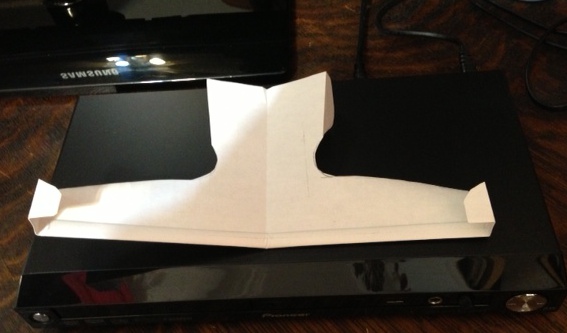
The previous plane was made from legal size paper, 8-1/2 x 14 inches. This plane is made from 11 x 14-1/4 inches paper, or a scaled-up size from 8-1/2 x 11 inches letter-size sheets. The folding technique is the tapered wing style. In tapered wing folding, you fold in half each way to start, then fold over the two front triangular corners and cut them off with a scissors. Flip and rotate the pieces and place them to match the remaining triangles on the forward section of the sheet. A small piece of tape at the center of the sheet to hold everything in place, then fold over the very forward tip about an eighth inch, or 3mm. Keep folding over and over until you reach the long fold that will be the leading edge of the wing. Run a strip of tape along the trailing edge of the fold to keep it closed. Press down hard on the fold to flatten it. The wing is now thick in the center and thin at the ends.
Cut out a barnaby shape from one side. Take this cutout and mark the other side. If you attempt to fold the plane is half, the center fold will crack. This extra thickness in the center keeps the plane stiff in flight. Fold in the ends about an inch and a half, and then fold over. Unfold to make the C wing ends.
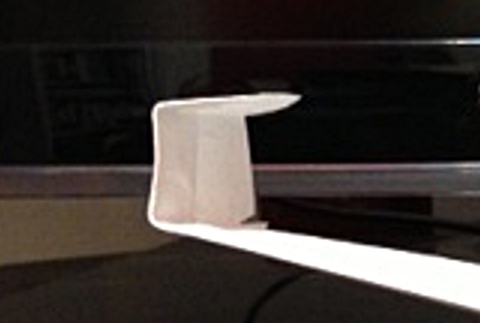
I like to take a snip about a quarter of the way in at the end of the wing to give the trailing edge more room for camber. Finish off the barnaby as usual; just be careful to balance the folds of the tail. I usually run strips of tape where the fuselage curves, to give it extra stiffness: a strip of tape along the keel will also help.
This flies much better than the yellow-pad legal-size plane. Capable of tight turns, adjustable to wide turns, very sensitive in roll (be careful balancing the plane, the control forces do not scale linearly with speed, so only small adjustments). It should be fine indoors and out, but looks to be happiest out-of-doors.
]]>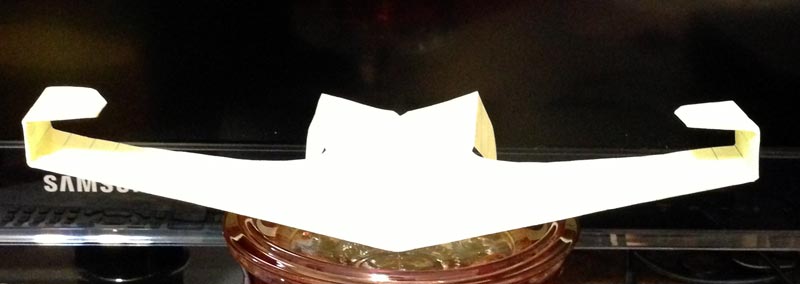
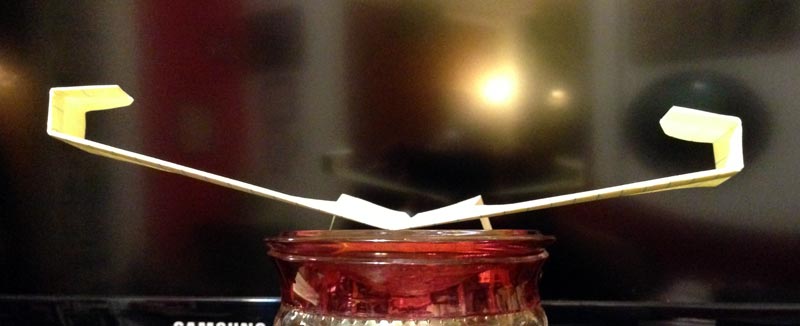
This uses a legal-size sheet of 16-pound paper. ( 8-1/2″ x 14″ or 216mm x 355.6mm and 60 grams per square meter). The full sheet of paper is 4.6 grams, or about 4 grams for the completed airplane. The rolled leading edge taped flat and folded is enough structure to keep the upper horizontal surface of the C wingtips relatively flat. The fold needs to be refreshed to remain horizontal. This plane flies quite well, with a L/D of 6 or more. No flutter when flying in circles or in glides. The original Barnaby glider had a full wingtip fold instead of a winglet. Who would have thought in 1908 a second fold would be a breakthrough in aerodynamics in 1995?
A small cut about a quarter of the way in on the initial folds that create the vertical wing panels allows the trailing edge of the wings more camber, which improves the L/D to 7. In addition, this provides more adjustment of the wing loading, which must be equal in order to fly in circles and return at the same altitude.
]]>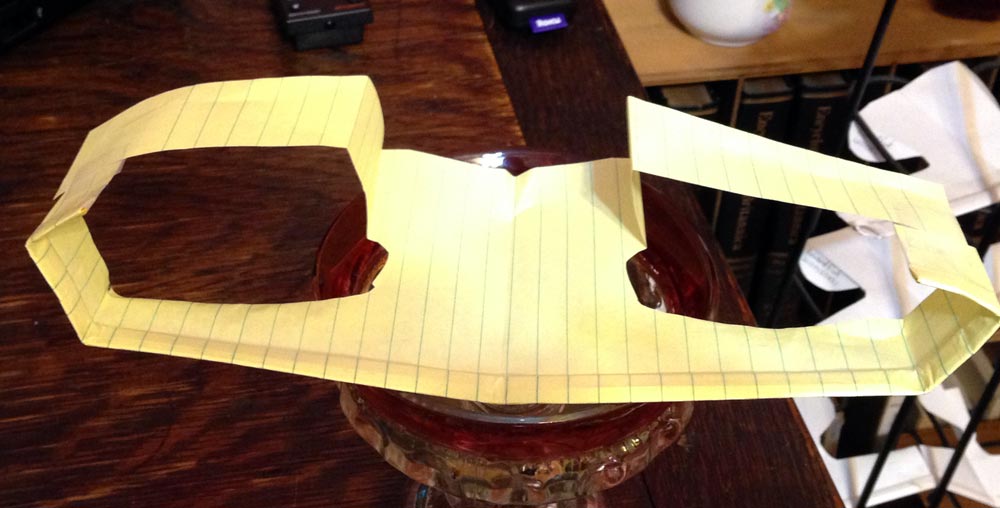
http://www.synergyaircraft.com/ describes a new concept in aircraft: the double box tail. I looked at the test flights of the model, and thought the Barnaby platform could be so modified. Starting with a legal size sheet of paper it was possible to make a double box tail aircraft. The winglets are an extension of the wing and have two folds. The upper surfaces are single thickness (no leading edge thickening with rolled up paper like the wing) and are stiffened by a longitudinal fold for the elevator effect. They are cut at an angle to meet the upper rear edge of the winglets. A bit of tape top and bottom attaches the tails to the winglets. This version has too much surface area, which results in a high sink rate, but it flies in circles and returns to the hand. The upper surfaces are truly tails, with the rear edges deflected up like an elevator.
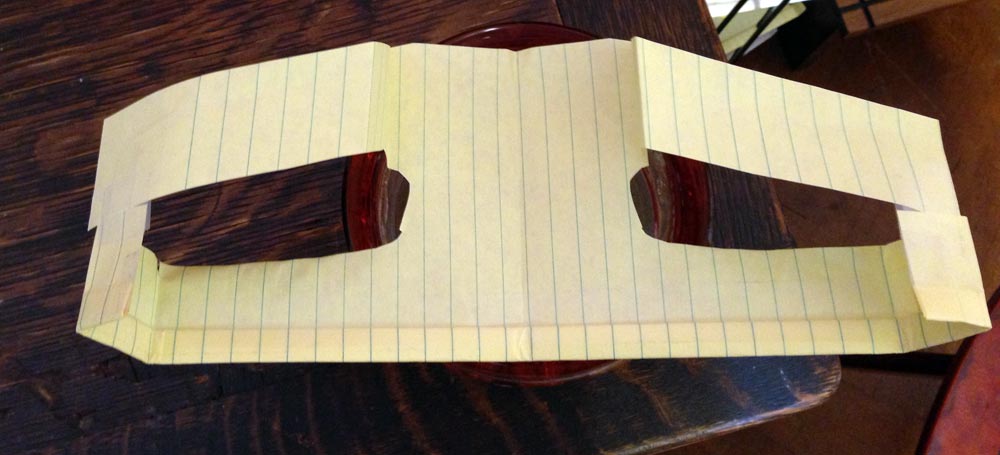


Boeing has announced the use of new winglets on the Boeing 737 Max. “Boeing has unveiled a new Advanced Technology winglet design concept for its 737 MAX family which the manufacturer says will provide customers with up to an additional 1.5 per cent fuel-burn improvement, depending on range, on top of the 10 to 12 per cent improvement it is already claiming for the new 737 variant.”
Here is a paper airplane with the advanced technology winglet. It uses the barnaby platform traditionally made: The leading edge is folded over repeatedly to make a thick leading edge. I then cut out the wingtips and split them with a scissors. They are still multiple sheets of paper, so they are wrapped with magic tape to keep the layers together.
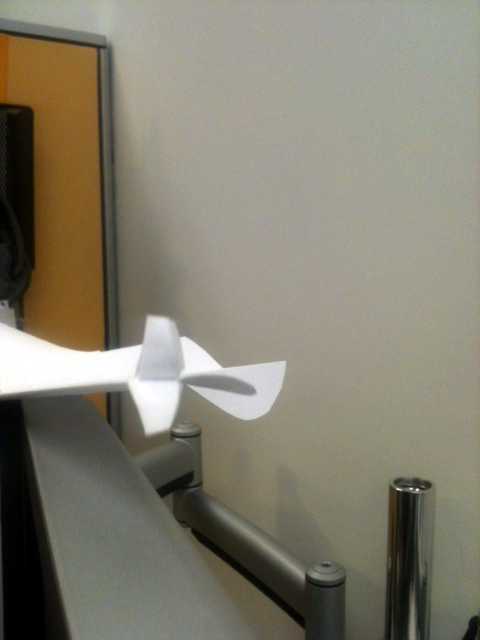
A close-up. The difference between advanced technology and split blended winglets: split blended winglets are staggered on the wingtip, and advanced technology winglets are stacked. Split blended winglets are curved, and advanced technology winglets are straight. This implementation of advanced technology winglets has them curved.

And here is the straight version. The lower winglet is shorter.
]]>
A search for blended winglets produced this link and this blog entry. Aviation Partners, the same folks who pioneered blended winglets and spiroid winglets are testing split blended winglets with scimitar tips. I thought I could reproduce split blended winglets, but didn’t feel the scimitar tips were necessary in the Reynolds environment of a butterfly.

The design uses the barnaby platform, with the tapered-fold leading edge to thin out the tips of the wings. The taper fold was made using a traditional fold of half in each direction, then, unfolded, I folded in the corners at the front, cut them off, and tucked them in when folding up the leading edge, to get the weight up front. The wing is thick in the middle and thins toward the end. The inital flight went about 25 feet ruler-straight down a back hallway. The second flight was equally straight. This looks like a win. ]]>


This is built similarly to the previous plane, but two extra folds produces a fuselage of sorts. It is a good place to put your index finger and makes the plane easier to launch.
]]>